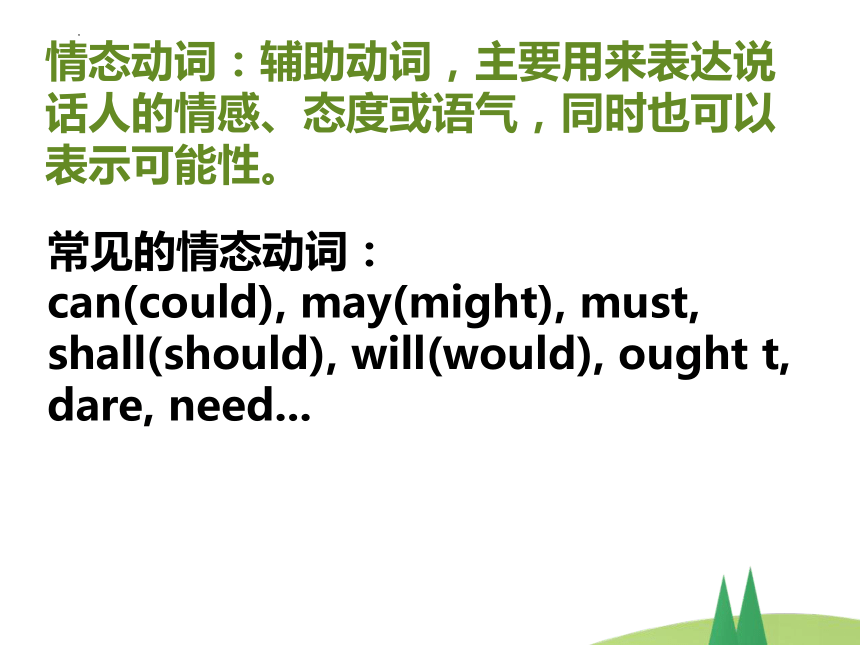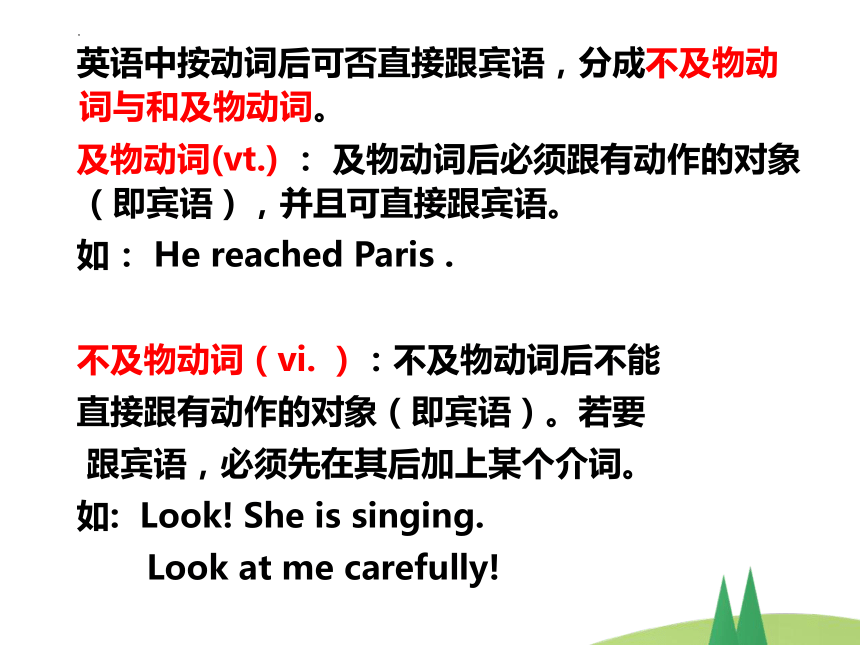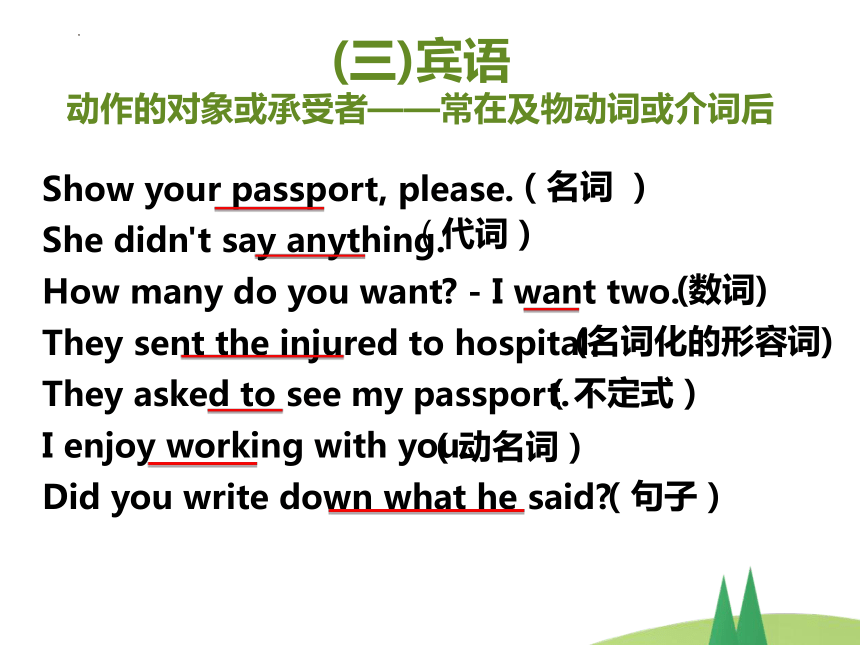中考英语句子成分分析课件(共23张PPT)
文档属性
| 名称 | 中考英语句子成分分析课件(共23张PPT) |  | |
| 格式 | pptx | ||
| 文件大小 | 891.3KB | ||
| 资源类型 | 教案 | ||
| 版本资源 | 通用版 | ||
| 科目 | 英语 | ||
| 更新时间 | 2024-10-27 16:50:22 | ||
图片预览









文档简介
(共23张PPT)
初中英语
句子成分分析
The sun rises in the east.
Twenty years is a short time in history.
The poor are now living in the shelter.
Seeing is believing.
To see is to believe.
He likes dancing.
What he needs is a book.
It is very clear that the elephant is round and tall like a tree.
(名词)
(代词)
(数词)
(动名词)
(不定式)
(句子)
(名词化的形容词)
(It形式主语,主语从句是真正主语)
㈠主语(subject)常位于句首动词前,句子说明的人或事物。
㈡谓语 动词,说明主语的动作、状态和特征。
简单谓语:由动词或动词词组组成
I saw the flag on the top of the hill
He looked after two orphans.
复合谓语 由情态动词或助动词+动词;
He can speak English well.
She doesn’t seem to like dancing
情态动词或助动词不是谓语!
情态动词:辅助动词,主要用来表达说话人的情感、态度或语气,同时也可以表示可能性。
常见的情态动词:
can(could), may(might), must, shall(should), will(would), ought t, dare, need...
英语中按动词后可否直接跟宾语,分成不及物动词与和及物动词。
及物动词(vt.) : 及物动词后必须跟有动作的对象(即宾语),并且可直接跟宾语。
如: He reached Paris .
不及物动词(vi. ):不及物动词后不能
直接跟有动作的对象(即宾语)。若要
跟宾语,必须先在其后加上某个介词。
如: Look! She is singing.
Look at me carefully!
Show your passport, please.
She didn't say anything.
How many do you want - I want two.
They sent the injured to hospital.
They asked to see my passport.
I enjoy working with you.
Did you write down what he said
(名词 )
( 代词)
(数词)
(名词化的形容词)
(三)宾语
动作的对象或承受者——常在及物动词或介词后
(不定式)
(动名词)
(句子)
宾语分为直接宾语(物)和间接宾语(人).
He gave me some books.
↓
间接
宾语
↓
直接
宾语
●please pass me the book.
●He bought his girlfriend some flowers.
(四)表语
表语在系动词后。
1. He is a teacher.
2. What the girl wants is that.
3. Five and five is ten.
4. He is asleep.
5. His father is in.
6. The picture is on the wall.
7. My watch is gone / missing / lost.
8. To see is to believe.
9. The question is whether they will come.
(名词)
(代词)
(数词)
(形容词)
(副词)
( 介词短语)
(形容词化的分词)
(不定式)
(表语从句)
系动词=be+感官系动词: sound, look, feel,smell, taste, remain...系动词不用于被动语态。
It sounds a good idea.
Tom looks thin.
The dress feels very soft.
Now I feel tired.
The food smells delicious.
The food tastes good.
The door remains open.
(五)定语
修饰或限制名词或代词的词、词组或从句
He is a clever boy.
His father works in a steel factory.
There are 54students in our class.
Do you know betty’s sister
He bought some sleeping pills.
His spoken language is good.
(形容词)
(名词)
(数词)
(名词的所有格)
(动名词)
(过去分词)
定语后置:
如果定语是由一个单词表示时,通常要前置。而由一个词组或一个句子表示时,通常则后置
The girl in red is his sister.
The girl standing under the tree is his daughter.
Do you know the man who spoke just now
(六)状语
状语说明地点、时间、原因、目的、结果、条件、方向、程度、方式和伴随状况等。
I will be back in a while.
They are playing on the playground.
He was late because he got up late.
He got up so late that I missed the train.
I waited to see you.
He often went to school by bus.
His parents died, leaving him an orphan.
Please call me if it is necessary.
This book is very interesting.
9种状语种类如下:
1. How about meeting again at six
2.Last night she didn’t go to the dance party because of the rain.
3.I shall go there if it doesn’t rain.
4.Mr Smith lives on the third floor.
5.She put the eggs into the basket with great care.
(时间状语)
(原因状语)
(条件状语)
(地点状语)
(方式状语)
5. She came in with a dictionary in her hand.
6.In order to catch up with the others, I must work harder.
7.He was so tired that he fell asleep immediately.
8.She works very hard though she is old.
9.I am taller than he is.
(伴随状语)
(目的状语)
(结果状语)
(让步状语)
(比较状语)
I found the book interesting.
Do you smell something burning
He made himself known to them.
(七)宾语补足语
说明宾语的身份和状态以进行补充,逻辑上与宾语是主谓关系。常有宾补的及物动词有 :
make, consider, cause, see, find, call, get, have, let.
She asked me to lend her a hand.
(八)同位语
位于名词或代词后面,说明它们的性质和情况
We young people should respect the old.
He himself will do the experiment.
He is the oldest among them four.
He told me the news that our team won the game.
名词
代词
数词
从句
句子的分类
分类 说明 例句
简 单 句 由一个主语或并列主 语和一个谓语或并列 谓语构成的句子。即 一套主谓关系。
1. Tom and I found her there.
2. We all breathe, eat and work.
并 列 句 由并列连词 (and,so,but, or等) 把两个或两个以上的 简单句连在一起而构 成的句子。 1. He likes eggs, but he doesn’t like chickens.
2. Work hard or you will fall behind.
复 合 句 由一个主句和一个或 一个以上的从句构成 的句子 1. I believe you are right.
2. If you study harder, you will pass the exam.
英语五种基本句型列式如下:
基本句型一: S +V (主+谓)
基本句型二: S +link-V +P (主+系+表)
基本句型三: S +V +O (主+谓+宾)
基本句型四: S +V +IO +O(主+谓+间宾+直宾)
基本句型五: S +V +O +C(主+谓+宾+宾补)
主谓宾、定状补,主干枝叶分清楚;
长难句,不畏惧,仔细琢磨心有数。
句子成份练习
1、You should study at school.
2、The teacher become very angry.
3、The boy told me his story.
4、We find the task difficult .
5、I told him an interesting story.
6、We watched the train leaving the station.
7、She is a beautiful girl.
状语
表语
(间接)宾语
宾语+宾补
间宾+直宾
宾语+宾补
定语
1.They work at the factory.
2.The flower is dead.
3.Plants need water.
4.He gives me some seeds.
主 + 谓 + 间宾 + 直宾
5.We should keep the plants in the shade.
主 + 谓 + 宾 + 宾补
6.Many animals live in trees. 主 + 谓+ 状
7.The boy in blue is my friend.
主 + 定+ 系+ 表
主 + 谓 + 状
主 + 系 + 表
主 + 谓 + 宾
7.He gave a dictionary to me .
主+谓+直接宾语+间接宾语
8.Shall I leave you the camera
主+谓+间接宾语+直接宾语
9. We find the book very interesting.
主+谓+宾+宾补
10.My uncle bought me an e-dictionary.
主+谓+间接宾语+直宾
11.Singing makes me happy.
主+谓+宾+宾补
1. I met my best friend Tom at the station yesterday.
↓
主语
↓
谓
语
↓
定语
↓
宾
语
↓
同位语
↓
状
语
初中英语
句子成分分析
The sun rises in the east.
Twenty years is a short time in history.
The poor are now living in the shelter.
Seeing is believing.
To see is to believe.
He likes dancing.
What he needs is a book.
It is very clear that the elephant is round and tall like a tree.
(名词)
(代词)
(数词)
(动名词)
(不定式)
(句子)
(名词化的形容词)
(It形式主语,主语从句是真正主语)
㈠主语(subject)常位于句首动词前,句子说明的人或事物。
㈡谓语 动词,说明主语的动作、状态和特征。
简单谓语:由动词或动词词组组成
I saw the flag on the top of the hill
He looked after two orphans.
复合谓语 由情态动词或助动词+动词;
He can speak English well.
She doesn’t seem to like dancing
情态动词或助动词不是谓语!
情态动词:辅助动词,主要用来表达说话人的情感、态度或语气,同时也可以表示可能性。
常见的情态动词:
can(could), may(might), must, shall(should), will(would), ought t, dare, need...
英语中按动词后可否直接跟宾语,分成不及物动词与和及物动词。
及物动词(vt.) : 及物动词后必须跟有动作的对象(即宾语),并且可直接跟宾语。
如: He reached Paris .
不及物动词(vi. ):不及物动词后不能
直接跟有动作的对象(即宾语)。若要
跟宾语,必须先在其后加上某个介词。
如: Look! She is singing.
Look at me carefully!
Show your passport, please.
She didn't say anything.
How many do you want - I want two.
They sent the injured to hospital.
They asked to see my passport.
I enjoy working with you.
Did you write down what he said
(名词 )
( 代词)
(数词)
(名词化的形容词)
(三)宾语
动作的对象或承受者——常在及物动词或介词后
(不定式)
(动名词)
(句子)
宾语分为直接宾语(物)和间接宾语(人).
He gave me some books.
↓
间接
宾语
↓
直接
宾语
●please pass me the book.
●He bought his girlfriend some flowers.
(四)表语
表语在系动词后。
1. He is a teacher.
2. What the girl wants is that.
3. Five and five is ten.
4. He is asleep.
5. His father is in.
6. The picture is on the wall.
7. My watch is gone / missing / lost.
8. To see is to believe.
9. The question is whether they will come.
(名词)
(代词)
(数词)
(形容词)
(副词)
( 介词短语)
(形容词化的分词)
(不定式)
(表语从句)
系动词=be+感官系动词: sound, look, feel,smell, taste, remain...系动词不用于被动语态。
It sounds a good idea.
Tom looks thin.
The dress feels very soft.
Now I feel tired.
The food smells delicious.
The food tastes good.
The door remains open.
(五)定语
修饰或限制名词或代词的词、词组或从句
He is a clever boy.
His father works in a steel factory.
There are 54students in our class.
Do you know betty’s sister
He bought some sleeping pills.
His spoken language is good.
(形容词)
(名词)
(数词)
(名词的所有格)
(动名词)
(过去分词)
定语后置:
如果定语是由一个单词表示时,通常要前置。而由一个词组或一个句子表示时,通常则后置
The girl in red is his sister.
The girl standing under the tree is his daughter.
Do you know the man who spoke just now
(六)状语
状语说明地点、时间、原因、目的、结果、条件、方向、程度、方式和伴随状况等。
I will be back in a while.
They are playing on the playground.
He was late because he got up late.
He got up so late that I missed the train.
I waited to see you.
He often went to school by bus.
His parents died, leaving him an orphan.
Please call me if it is necessary.
This book is very interesting.
9种状语种类如下:
1. How about meeting again at six
2.Last night she didn’t go to the dance party because of the rain.
3.I shall go there if it doesn’t rain.
4.Mr Smith lives on the third floor.
5.She put the eggs into the basket with great care.
(时间状语)
(原因状语)
(条件状语)
(地点状语)
(方式状语)
5. She came in with a dictionary in her hand.
6.In order to catch up with the others, I must work harder.
7.He was so tired that he fell asleep immediately.
8.She works very hard though she is old.
9.I am taller than he is.
(伴随状语)
(目的状语)
(结果状语)
(让步状语)
(比较状语)
I found the book interesting.
Do you smell something burning
He made himself known to them.
(七)宾语补足语
说明宾语的身份和状态以进行补充,逻辑上与宾语是主谓关系。常有宾补的及物动词有 :
make, consider, cause, see, find, call, get, have, let.
She asked me to lend her a hand.
(八)同位语
位于名词或代词后面,说明它们的性质和情况
We young people should respect the old.
He himself will do the experiment.
He is the oldest among them four.
He told me the news that our team won the game.
名词
代词
数词
从句
句子的分类
分类 说明 例句
简 单 句 由一个主语或并列主 语和一个谓语或并列 谓语构成的句子。即 一套主谓关系。
1. Tom and I found her there.
2. We all breathe, eat and work.
并 列 句 由并列连词 (and,so,but, or等) 把两个或两个以上的 简单句连在一起而构 成的句子。 1. He likes eggs, but he doesn’t like chickens.
2. Work hard or you will fall behind.
复 合 句 由一个主句和一个或 一个以上的从句构成 的句子 1. I believe you are right.
2. If you study harder, you will pass the exam.
英语五种基本句型列式如下:
基本句型一: S +V (主+谓)
基本句型二: S +link-V +P (主+系+表)
基本句型三: S +V +O (主+谓+宾)
基本句型四: S +V +IO +O(主+谓+间宾+直宾)
基本句型五: S +V +O +C(主+谓+宾+宾补)
主谓宾、定状补,主干枝叶分清楚;
长难句,不畏惧,仔细琢磨心有数。
句子成份练习
1、You should study at school.
2、The teacher become very angry.
3、The boy told me his story.
4、We find the task difficult .
5、I told him an interesting story.
6、We watched the train leaving the station.
7、She is a beautiful girl.
状语
表语
(间接)宾语
宾语+宾补
间宾+直宾
宾语+宾补
定语
1.They work at the factory.
2.The flower is dead.
3.Plants need water.
4.He gives me some seeds.
主 + 谓 + 间宾 + 直宾
5.We should keep the plants in the shade.
主 + 谓 + 宾 + 宾补
6.Many animals live in trees. 主 + 谓+ 状
7.The boy in blue is my friend.
主 + 定+ 系+ 表
主 + 谓 + 状
主 + 系 + 表
主 + 谓 + 宾
7.He gave a dictionary to me .
主+谓+直接宾语+间接宾语
8.Shall I leave you the camera
主+谓+间接宾语+直接宾语
9. We find the book very interesting.
主+谓+宾+宾补
10.My uncle bought me an e-dictionary.
主+谓+间接宾语+直宾
11.Singing makes me happy.
主+谓+宾+宾补
1. I met my best friend Tom at the station yesterday.
↓
主语
↓
谓
语
↓
定语
↓
宾
语
↓
同位语
↓
状
语
同课章节目录
